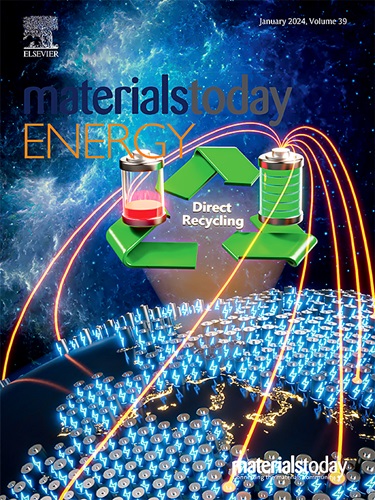氧功能化金刚石纳米锥阵列耦合酞菁钴,用于增强二氧化碳的电化学还原作用
IF 8.6
2区 材料科学
Q1 CHEMISTRY, PHYSICAL
引用次数: 0
摘要
高效催化剂的开发在推进一氧化碳电还原技术方面发挥着至关重要的作用。在潜在的候选催化剂中,基于金刚石的电催化剂因其宽广的电化学窗口而大有可为,它能有效抑制竞争性氢进化并确保较高的 CO 还原效率。在本研究中,我们报告了一种由氧端金刚石纳米锥(OD)和 CoPc 分子锚定(CoPc/OD)组成的集成电极。CoPc/OD 电极表现出卓越的性能,在 -0.97 V 与可逆氢电极 (RHE) 相比时,对 CO 的最大法拉第效率 (FE) 达到 94.1%,并且在 -0.67 V 至 -1.07 V 与 RHE 相比的宽电位范围内,FE 保持在 80% 以上。CoPc/OD 电极的出色性能可归因于纳米结构金刚石表面与 CoPc 催化剂之间的协同效应。金刚石表面富含羟基的性质有利于 CoPc 分子的锚定以及与 CoPc 中 Co 原子的结合。同时,具有尖锐尖端的纳米结构金刚石增强了对 CO 的吸附,从而提高了催化剂的性能。这项研究为利用非金属碳材料(尤其是金刚石)作为一氧化碳电化学还原中的无金属催化剂提供了宝贵的见解,并解决了低电流密度和低法拉第效率等难题,从而有助于开发更有效的一氧化碳电还原催化剂。本文章由计算机程序翻译,如有差异,请以英文原文为准。

Oxygen functionalized diamond nanocone arrays coupling cobalt phthalocyanine for enhanced electrochemical CO2 reduction
The development of high-efficiency catalysts plays a crucial role in advancing CO electroreduction techniques. Among potential candidates, diamond-based electrocatalysts show promise due to their broad electrochemical windows, which effectively suppress competitive hydrogen evolution and ensure high CO reduction efficiency. In this study, we report an integrated electrode composed of oxygen-terminated diamond nanocone (OD) with CoPc-molecules anchoring (CoPc/OD). The CoPc/OD electrodes exhibited remarkable performance, achieving a maximum Faradaic efficiency (FE) of 94.1% for CO at −0.97 V vs reversible hydrogen electrode (RHE), and maintaining an FE higher than 80% over a wide potential range of −0.67 V to −1.07 V vs RHE. The outstanding performance of the CoPc/OD electrode can be attributed to the synergistic effects between the nanostructured diamond surface and the CoPc catalyst. The hydroxyl-rich nature of the diamond surface facilitates the anchoring of CoPc molecules and bonding with Co atoms in CoPc. Simultaneously, the nanostructured diamond with sharp tips enhances CO adsorption, thereby improving the catalyst's performance. This study provides valuable insights into the utilization of non-metallic carbon materials, particularly diamond, as metal-free catalysts in CO electrochemical reduction and tackles challenges such as low current density and poor Faradaic efficiency, thus contributing to the advancement of more effective catalysts for CO electroreduction.
求助全文
通过发布文献求助,成功后即可免费获取论文全文。
去求助
来源期刊

Materials Today Energy
Materials Science-Materials Science (miscellaneous)
CiteScore
15.10
自引率
7.50%
发文量
291
审稿时长
15 days
期刊介绍:
Materials Today Energy is a multi-disciplinary, rapid-publication journal focused on all aspects of materials for energy.
Materials Today Energy provides a forum for the discussion of high quality research that is helping define the inclusive, growing field of energy materials.
Part of the Materials Today family, Materials Today Energy offers authors rigorous peer review, rapid decisions, and high visibility. The editors welcome comprehensive articles, short communications and reviews on both theoretical and experimental work in relation to energy harvesting, conversion, storage and distribution, on topics including but not limited to:
-Solar energy conversion
-Hydrogen generation
-Photocatalysis
-Thermoelectric materials and devices
-Materials for nuclear energy applications
-Materials for Energy Storage
-Environment protection
-Sustainable and green materials
 求助内容:
求助内容: 应助结果提醒方式:
应助结果提醒方式:


